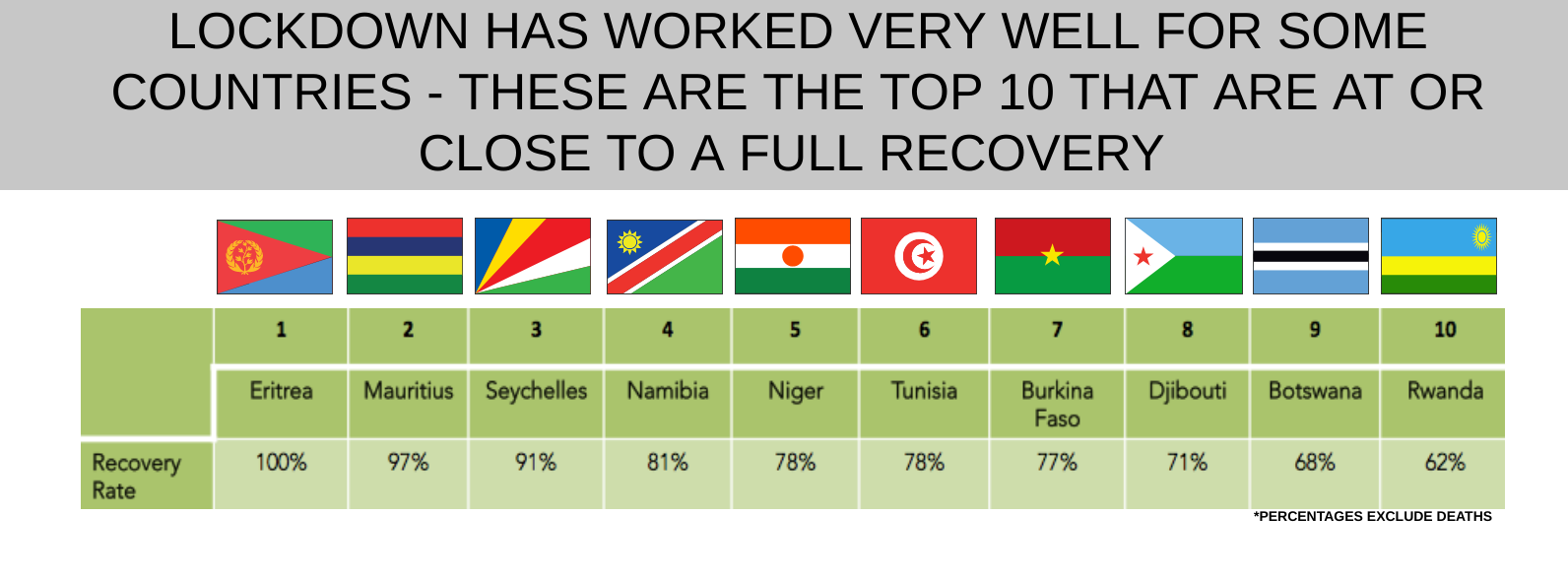Updated Weekly
As world leaders meet virtually for the World Health Assembly this week, is it premature to be talking about winning the COVID19 fight? Over the past few months, as we have provided our weekly updates on what African countries are doing to tackle COVID19, we have noticed some positive trends, especially with respect to managing the health effects of COVID19. Yes, there are many countries still facing huge challenges, but there are others leading the way, providing a realistic example for others to emulate within the continent as well as having their own impact on overall numbers.
How are they winning (and by implication, how are others still fighting)? Our data today and over the past two months reveals the following three central strategies African countries have employed, which may well be key to maintaining and avoiding “second waves” for the newly winning countries.
First, act and lockdown COVID19 hotspots quickly. Several weeks ago, we found that the majority of African countries closed (in particular air) borders and started some degree of social distancing early – 69% before they recorded 10 cases. Even Lesotho, the last African country to record a case (which happened last week) had done so. This is an incredible record. Island countries such as Mauritius and Seychelles have been able to contain and track the virus, and with high recovery rates 3 African countries have now declared themselves “COVID19 Free”. That means a return to relative normality for citizens while governments work out how to deal with the domestic implications of the global slowdown in key sectors – such as trade and tourism, and how to begin and maintain a recovery in those areas.
Second, slow the spread of the virus by either using “stay at home” orders OR enforcing mandatory use of face-masks in public areas combined with curfews. Very few African countries have not done at least one of these, and even countries with large Muslim populations have done their best to enforce this over the Ramadan period. The results are showing. Unlike the rest of the world, the data shows that even for the countries with the largest numbers of cases on the continent their “curves” are not rising exponentially. They are only slowly rising, and therefore avoiding overwhelming health systems. Similarly, deaths across the continent are lower in proportion to the rest of the world – 9 African countries that have not seen any deaths so far. These are huge achievements.
Third, ramp up testing to understand and control the virus. Over the last two weeks, African countries have doubled the total tests completed – from around 785 thousand to over 1.56 million. However, Africa remains far behind the world on this marker. As a comparison, last week, China announced that it would be testing 11 million people in Wuhan over a similar time-period. In addition, we are starting to see several countries increase testing at borders, which could become flash-points of COVID19 challenges. Learning from mistakes that have been made in some Asian economies, and as our CEO has written elsewhere, the key will be to report on such cases ethically and sensitively – to avoid stigmatising and victimising migrants, those who have to travel across borders for their work, or even refugees or poor people in crowded areas. This will be a key challenge for African governments, and WHO and Africa CDC support to help provide the right solution for communications will be key.
But what about the countries still facing challenges? The countries still facing the risk of exponential outbreaks?
Our data indicates some countries that continue to see significant rises not driven by testing uplifts – including Cameroon, Sudan, Somalia, Nigeria and South Sudan, and others that have not updated data such as Tanzania. And there are still 7 African countries that have completed less than 1,000 tests, and another 5 that don’t release any testing data.
Based on the evidence, our recommendation to these African governments is to – as quickly as possible – switch to the three strategies being used by others on the continent, as well as appeal to the international community for more support as soon as possible. This week we have highlighted the Chinese medical teams that have been deployed so far to African countries, who could play a positive role. While the methodology for determining which African countries are priorities remains unclear – the best correlation we can find is higher Chinese Foreign Direct Investment – based on the announcement from President Xi at the World Health Assembly – it seems likely that teams from all over China will be available to go to many more countries soon. It will be worth African countries in need speaking to Chinese counterparts to request such support as soon as possible.
Check out the data below, and let us know your reflections and suggestions for further lines of enquiry.

To find out how Development Reimagined can help you, your organisation or Government during the COVID-19 outbreak please email the team at clients@developmentreimagined.com .
Special thanks go to Rosie Wigmore, Rosie Flowers, Wang Yu and Angela Benefo for their work on the graphic and collecting/analysing the underlying data.
The data was collated from a range of sources including: government websites and media reports, the IMF policy tracker; the US Chamber COVID19 Dashboard; Our World in Data, Africa CDC and Worldometer. Data on Chinese workers and FDI was from the China Africa Research Initiative and Chinese medical teams from Chinese state media reporting. Our methodology is entirely in-house, based on analysis of social distancing categories and other trends.
If you spot any gaps, please send your feedback to us at DRteam@developmentreimagined.com, we will aim to verify and rectify asap.
May 2020


